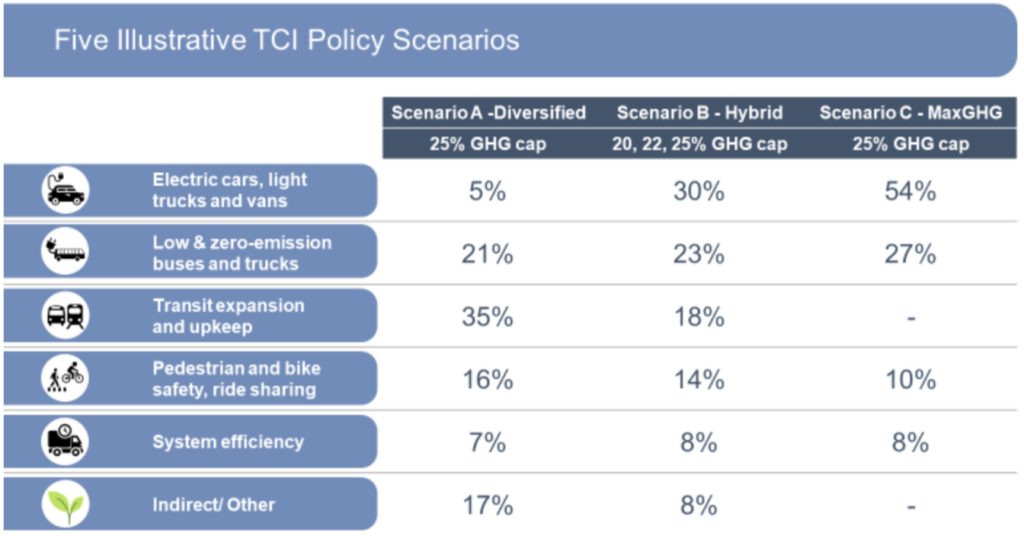February 25, 2021: The preliminary TRECH results have been updated to account for the full effect of changes in nitrogen dioxide emissions from on-road transportation sources and to incorporate estimates of childhood asthma incidences and exacerbations. With these updates, the estimated benefits of the health outcomes we studied are $13.5 billion in 2032 for the top-performing scenario, up from $11.1 billion when we initially released our estimate last October. All results below reflect what could occur if the 12 Northeast and Mid-Atlantic states and the District of Columbia participate in the Transportation & Climate Initiative program. At this time, three states (MA, CT, and RI) and the District of Columbia have signed a memorandum of understanding to participate in the TCI program.
January 28, 2020: Investments in infrastructure to promote bicycling and walking could save as many as 770 lives and $7.6 billion each year across 12 Northeast and Mid-Atlantic states and the District of Columbia under the proposed Transportation and Climate Initiative (TCI), according to a Boston University School of Public Health (BUSPH) and Harvard T.H. Chan School of Public Health study. Read more
- Download the complete Research Update
- Download the Technical Appendix
- Download the slide presentation
The Context
Transportation is the largest source of greenhouse gas (GHG) emissions in the United States and in the Northeast and Mid-Atlantic regions at 28% and 35%, respectively, in 2018 (EPA 2020). Cars, trucks, and buses also emit tons of conventional air pollutants each year contributing to asthma, heart disease, preterm births, and premature death among other health impacts. The largest air quality impacts occur in underserved and overburdened communities, near highways and transportation depots, and among Black people and other people of color, due to a long history of racist policies that have resulted in persistent elevated pollution exposure. Transportation systems also affect noise pollution; congestion and stress; opportunities for safe biking and walking; and access to jobs, healthcare, and education.
A group of Northeast and Mid-Atlantic states and the District of Columbia are engaged in a planning process for the Transportation & Climate Initiative (TCI) which aims to cut carbon dioxide (CO2) emissions from the transportation sector. In December 2020, three states (MA, CT, and RI) and the District of Columbia signed a memorandum of understanding to participate in the TCI program. The TRECH Project results below reflect the benefits that could occur if all 12 Northeast and Mid-Atlantic states and the District of Columbia participate in the program. The TRECH Project team is making its preliminary health assessment results available as state policymakers and stakeholders consider how best to design a TCI climate mitigation program and achieve health gains.
The TRECH Project
The Transportation, Equity, Climate and Health (TRECH) Project is a multi-university research initiative conducting an independent analysis of policy scenarios to address carbon pollution from the transportation sector. The project looks at changes in health outcomes from active mobility (e.g., biking and walking) and air quality using published, peer-reviewed models commonly employed in regulatory analysis. To date, the TRECH Project team has estimated health outcomes for five illustrative TCI policy scenarios representing a range of emissions reduction caps and investment strategies.
The preliminary TRECH results, updated on February 25, 2021, are intended to foster dialogue and help inform program design and implementation by illustrating how climate mitigation policies in the transportation sector can influence health and equity outcomes. The actual benefits of a TCI program will depend on state policy decisions including the ambition of a CO2 emissions reduction cap, the formulas for allocating program proceeds among and within states, and the potential adoption of supporting policies.
Insights from Preliminary Results
- Assuming all Northeast and Mid-Atlantic states and the D.C. participate in TCI, the estimated health benefits under the five regional TCI climate policy scenarios are substantial and are larger than estimated TCI program proceeds, for a subset of total possible benefits. The preliminary results show that the estimated health benefits from changes in active mobility and on-road emissions under TCI policy scenarios that assume all 12 Northeast and Mid-Atlantic states and the District of Columbia are participating include: 320 to 1,360 deaths avoided, 48 to 230 incidences of childhood asthma avoided, and tens of thousands of childhood asthma exacerbations avoided annually when the program is fully implemented in 2032 (Table 1). The monetized value of this subset of total health benefits are larger than the estimated annual TCI program proceeds in 2032 under all of the TCI policy scenarios (Table 1). This analysis does not include climate-related health benefits and other potential health benefits from improving transportation systems such as those from reduced traffic congestion and noise pollution as well as improved traffic safety and access to jobs, healthcare, and education. See the caveats below for additional key assumptions in these scenarios.
- The TCI policy scenario with the largest estimated health benefits has the most ambitious emissions reduction cap and the largest share of investments dedicated to public transit and active mobility. The TCI policy scenario that achieves the largest overall health benefits is the one with the most ambitious CO2 emissions reduction cap (25%) and an investment portfolio focused on public transit and walking and biking infrastructure (Scenario A)(Table 1). This scenario also does the most to reduce inequalities in air pollution exposure by race/ethnicity, has the smallest difference between rural and urban benefits, and achieves the largest CO2 emission reductions from on-road sources of the five policy scenarios examined.
Table 1: Estimated Health Benefits for Five Illustrative TCI Policy Scenarios Compared to a No-TCI Reference Scenario in 2032 (central estimates, billions of 2016$)
| Scenario A
25% CO2 Reduction Cap |
Scenario B
25% CO2 Reduction Cap |
Scenario C
25% CO2 Reduction Cap |
Scenario B
22% CO2 Reduction Cap |
Scenario B
20% CO2 Reduction Cap |
|
| Total deaths avoided (biking, walking, and air quality) | 1360 | 1160 | 840 | 640 | 320 |
| Estimated monetized benefits of 8 health outcomes | $13.5 | $11.6 | $8.3 | $6.3 | $3.3 |
| Estimated annual TCI proceeds in 2032 (billions of 2016$) | $8.5 | $6.8 | $5.4 | $3.5 | $1.9 |
- Under all five policy scenarios, health benefits are estimated to occur in all counties across the region and are concentrated in more populated areas. All counties in the region are estimated to receive both active mobility and air quality benefits under all five TCI policy scenarios considered here. Both the total and per capita health benefits are concentrated in more populated counties. These findings illustrate that widespread benefits are possible when proceeds are broadly distributed across the region and most (83% to 92%) of the proceeds are reinvested in transportation system improvements.
- All five policy scenarios modestly reduce inequities in air pollution exposure between racial/ethnic groups but, even with the reductions estimated under the TCI policy scenarios, people of color would still face higher overall air pollution exposures and more emission reductions would be needed to address these pre-existing inequities. All five policy scenarios are estimated to result in some reduction in air pollution exposure inequality in the region compared to the no-TCI reference scenario in 2032, with greater relative reductions in exposure for non-Hispanic Black and Hispanic populations. However, while non-Hispanic Black and Hispanic populations, on average, are estimated to see slightly larger decreases in air pollution, they would still face higher overall air pollution exposures and more pollution reductions would be needed to address these longstanding inequities and related health outcomes.
- The four-fold difference in the estimated health benefits exists across the five TCI policy scenarios, underscoring that there is a wide range of possible health outcomes and that actual health benefits will depend on state participation and state actions (Table 1).
About the Illustrative TCI Policy Scenarios
Under the proposed TCI cap and invest policy structure, fuel suppliers would be required to hold allowances for the carbon content of the fuel they supply. The allowances would be auctioned off and the proceeds from those auctions would be allocated to states to reinvest. The illustrative TCI policy scenarios assume that the proceeds are allocated to the participating states based on vehicle miles traveled and population. Each scenario allocates a percent of the program proceeds to 25 different transportation strategies bundled into five categories. Of the total auction proceeds, 83% to 92% is assumed to be reinvested in transportation improvements. The remainder is allocated to the category “indirect/other.”
To date, the TRECH Project team has analyzed five illustrative TCI policy scenarios compared to a no-TCI policy scenario in 2032. The policy scenarios represent three carbon dioxide (CO2) emissions reduction caps and three investment and policy mixes defined by states participating in the TCI process.
The three investment and policy mixes for the illustrative TCI scenarios examined here represent an emphasis on public transit and active mobility (Scenario A), an emphasis on vehicle electrification and fuel-switching (Scenario C), and a blend between the two (Scenario B).
The three caps examined here represent a 20%, 22%, and 25% CO2 emissions reduction from on-road vehicles from 2022 levels by 2032. This equates to a 1%, 3%, and 6% reduction in emissions from a no-TCI reference scenario in 2032. For this research update, Scenario B was modeled with all three caps. Scenarios A and C were modeled with the 25% CO2 emissions reduction cap. Additional scenarios will be analyzed in phase 2 of the TRECH Project. For more details, see the reference and policy scenario assumptions and the TCI strategy investment tool.
A Few Caveats
- The TCI policy scenarios examined here are illustrative, not predictive, and are for the purpose of informing program design. Actual health benefits will depend on state participation and state actions.
- The scenarios assume that all 12 Northeast and Mid-Atlantic states and the District of Columbia are participating in the TCI program in 2032.
- The scenarios assume that 83% to 92% of proceeds are reinvested in the transportation system.
- The analysis focuses on on-road emissions and does not directly incorporate potential changes in emissions from the electrical grid. A basic screening analysis was conducted to assess the scale of potential grid effects.
- The air quality analysis was conducted at a 12 kilometer by 12 kilometer scale, which is much smaller than a county but larger than a neighborhood. This is highly detailed for a regional analysis but is not intended to be used for examining changes at a neighborhood scale.
- The analysis does not include climate-related health benefits and potential transportation-related health benefits that could accrue from changes in safety, noise pollution, traffic congestion, and access to jobs, healthcare, and education.
What’s Next?
In the months ahead, the TRECH Project team plans to:
- Submit the current research for publication
- Continue to expand community engagement
- Conduct additional equity analyses
- Define and model additional transportation scenarios
- Integrate changes in power sector emissions
- Develop one or more case studies at a neighborhood scale
Download the complete Research Update
Download the Technical Appendix
Download the slide presentation
TRECH Project Team
- Sarav Arunachalam, PhD, Institute for the Environment, University of North Carolina, Chapel Hill
- Calvin Arter, PhD candidate, University of North Carolina at Chapel Hill
- Alique Berberian, MPH, Columbia Center for Children’s Environmental Health
- Laura Buckley, PhD student, Boston University School of Public Health
- Jonathan Buonocore, ScD, Center for Climate, Health, and the Global Environment, Harvard T.H. Chan School of Public Health
- Charles Chang, MA, Institute for the Environment, University of North Carolina at Chapel Hill
- Kathy Fallon Lambert, MS, Center for Climate, Health, and the Global Environment, Harvard T.H. Chan School of Public Health
- Patrick Kinney, ScD, Boston University School of Public Health
- Jon Levy, ScD, Boston University School of Public Health
- Frederica Perera, DrPH, PhD, Columbia Center for Children’s Environmental Health
- Matthew Raifman, PhD student, Boston University School of Public Health
Contacts
- Project contact: Kathy Fallon Lambert, Senior Advisor, Harvard Chan C-CHANGE, klambert@hsph.harvard.edu
- Media contact: Anna Miller, Sr. Communications Coordinator, Harvard Chan C-CHANGE, amiller@hsph.harvard.edu
References
Arter, C., S. Arunachalam, A. Berberian, L. Buckley, J. Buonocore, C. Chang, K. Fallon Lambert, P. Kinney, J. Levy, F. Perera, M. Raifman. 2020. Health and Equity Impact Assessment of the Transportation Climate Initiative. Conference presentation. 30th Annual Meeting of the International Society of Exposure Science (ISES), September 22, 2020.
Arunachalam, S., C. Arter, A. Berberian, L. Buckley, C. Chang, D. Cooley, K. Fallon Lambert, J. Levy, F. Perera, J. Buonocore. Air Pollution and Health Benefits under the Transportation Climate Initiative. In preparation.
Driscoll, C.T, J. Buonocore, J. Levy, K. Fallon Lambert, D. Burtraw, S. Reid, et al. 2015. U.S power plant carbon standards and clean air and health co-benefits. Nature Climate Change: 5(6), 535-540.
Raifman, M., K. Fallon Lambert, J. Levy, P. Kinney. 2021. Mortality Implications of Increased Active Mobility for a Proposed Regional Transportation Emissions Cap-and-Invest Program. Journal of Urban Health. https://doi.org/10.1007/s11524-020-00510-1.
U.S. Environmental Protection Agency. 2020. Inventory of U.S. Greenhouse Gas Emissions and Sinks: 1990–2018. https://www.epa.gov/ghgemissions/sources-greenhouse-gas-emissions.
Acknowledgements
The TRECH Project is made possible in part by a grant from the Barr Foundation to the Center for Climate, Health, and the Global Environment at the Harvard T.H. Chan School of Public Health.














